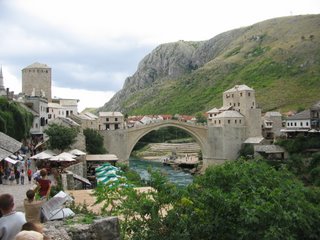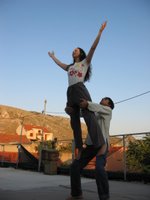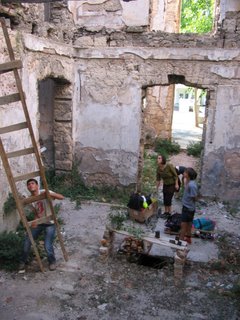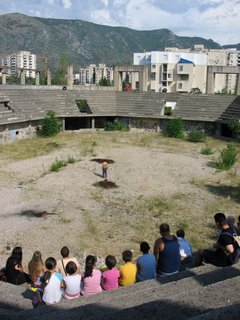 Mostar, BOSNIA and HERZEGOVINA: August 2006: As many of you know we have recently returned from the second meeting of Performing Artist for Balkan Peace. Once again we came together with artists from across the Balkans and Eastern Europe to share our artistry, vision, frustrations, and hopes. The experience was, in a word, inspirational.
Mostar, BOSNIA and HERZEGOVINA: August 2006: As many of you know we have recently returned from the second meeting of Performing Artist for Balkan Peace. Once again we came together with artists from across the Balkans and Eastern Europe to share our artistry, vision, frustrations, and hopes. The experience was, in a word, inspirational.Our original idea was to create a sustainable and expandable network of performing artists devoted to cross-border collaboration, social progress and peace. In 2005, we met in Bulgaria and worked closely together, sharing techniques, discussing the issues facing the Balkans, improvising on these themes, and collaborating in crafting the final production of Honey and Blood. Through the process of co-creation we had all given birth to the same child and we had now returned to see it grow. It was with the greatest pleasure and camaraderie that we began our second collaboration.

We had seven days to reconstruct Honey and Blood as the opening performance of Mostar Youth Theatre’s Festival of Authorial Poetics, an annual festival that attracts students and professionals from around the world for an intensive series of workshops and performances. Our plan was that this environment would offer the best opportunity to introduce the PABP to an international community. Through that first week, we were amazed at our creative ease as a group as we re-discovered our way of working together. Honey and Blood opened the Festival with a positive response from an eager crowd and many stayed afterwards to discuss our collaboration in more detail. We encouraged the artists to join the PABP over the next week for the second phase of our project: creating a site-specific work which would transform destroyed sites around the city into performance spaces, celebrate the city of Mostar, and reflect on local issues and those facing the region.
 The City of Mostar is a dramatic and inspiring backdrop for site-specific work, a place of visual contradictions. ten years after the war, the scars of war are still highly visible to locals and strangers alike. Exoskeletons of bombed buildings riddled with bullet holes and broken glass still stand in central locations throughout the town next door to renovated modern buildings. We used the destruction to draw our creative impulses. With the help of Mostar Youth Theatre, we picked three sites and the directors decided to work in pairs to heighten the collaborative experience for them. We decided to connect the three performances with a pageant or parade from one site to another which would gather passers-by and involve the town even more directly.
The City of Mostar is a dramatic and inspiring backdrop for site-specific work, a place of visual contradictions. ten years after the war, the scars of war are still highly visible to locals and strangers alike. Exoskeletons of bombed buildings riddled with bullet holes and broken glass still stand in central locations throughout the town next door to renovated modern buildings. We used the destruction to draw our creative impulses. With the help of Mostar Youth Theatre, we picked three sites and the directors decided to work in pairs to heighten the collaborative experience for them. We decided to connect the three performances with a pageant or parade from one site to another which would gather passers-by and involve the town even more directly. We had five days to complete this work, a hurried but fruitful process. The three groups worked separately during the day and re-convened in the evenings to share daily discoveries. Each group immediately found their distinct style of working, influenced by the unique choice of actors and theatrical backgrounds, but mostly inspired by the space that t
 hey had chosen. We all used resources found on location and little else. The groups realized that this site-specific work was very useful in that it mimicked the conditions we find in our outreach work in refugee camps, prisons, orphanages – that is, few resources.
hey had chosen. We all used resources found on location and little else. The groups realized that this site-specific work was very useful in that it mimicked the conditions we find in our outreach work in refugee camps, prisons, orphanages – that is, few resources.We decided that annual meetings are desirable even if the entire membership is not present, and that this will provide the opportunity to introduce new groups into the mix. We also plan to include a community outreach component as a commitment to our shared mission of social progress. Our plan for 2007 is to meet in the newly renovated Theatre Dodona in Pristina, Kosovo, a heroic theatre during the war, and also to work with a youth center in the still-volatile town of Mitrovica.
